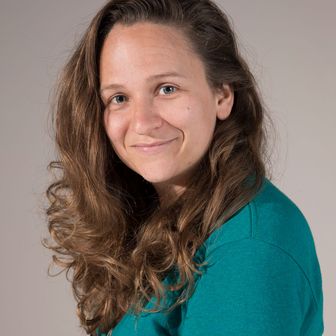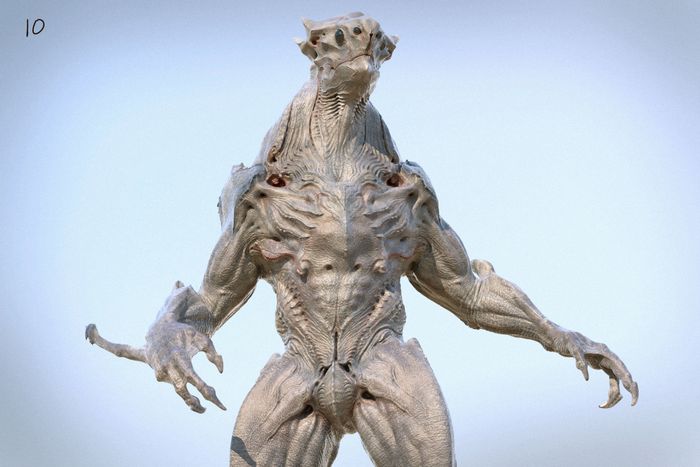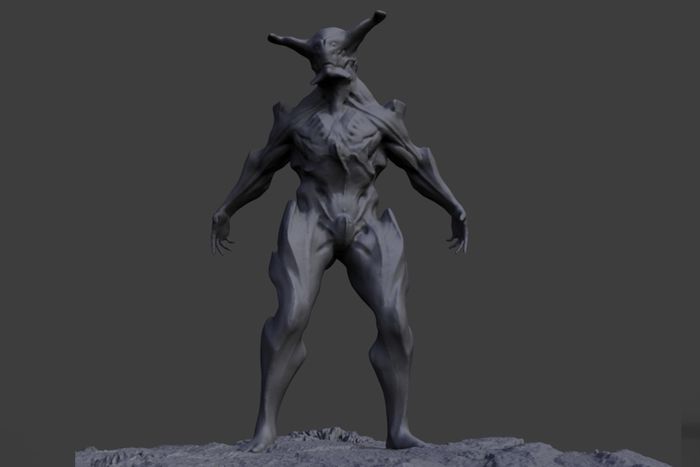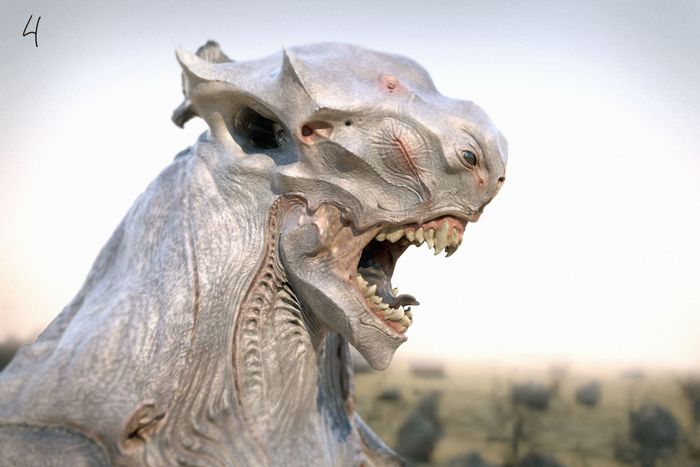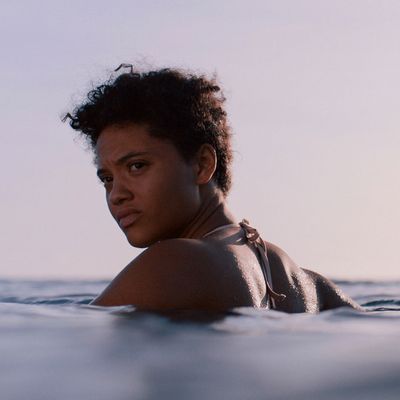
The thing about a creature feature is: You expect to see the creature. In J.D. Dillard’s latest film in the genre, Sweetheart, you technically do catch sight of a monster, but the director takes a very J.J. Abrams–esque approach to the reveal. His creature, which appears to a young woman named Jenn (Kiersey Clemons) while she’s stranded on an island, exists mostly in the shadows and out of focus. As our protagonist struggles to survive, she finds only remnants at first — not of the beast in question but of its presumed prey. As she comes to terms with the fact that she is not alone, that something else is claiming the pristine beaches, the monster gradually begins to reveal itself in glimpses. Its presence eventually blankets the entire film, which debuted at Sundance earlier this year and is now available to stream, but the monster’s full form is never shown in earnest.
Despite its lack of screen time, Dillard’s creature is actually a full-fledged monster whose every inch was considered during production and by none other than famed designer Neville Page. An extremely accomplished effects specialist known for his work on spectacle movies like Cloverfield, Avatar, and Prometheus, Page has known Dillard since their days together at Abrams’s Bad Robot Productions, which explains why Page joined this atypically (for him, anyway) small picture. “I thought, For J.D., I will become available,” says Page, who agreed to work within Sweetheart’s modest budget. “I don’t want to make it sound too much like it’s two bros working on some stuff together, but in the end, it kind of became that. I just wanted it to be so right for J.D., and my proposal to him was ‘I’ll finish when it’s done.’”
Page set to work creating not just an expertly crafted creature in the literal sense but one with a backstory the designer could reference when imagining how its movements should correspond with its intentions. The monster’s body parts aren’t simply decorative but are functional; almost everything was built upon a biologically sound foundation. “The design of something is all about being as inventive, being as thorough with regard to anatomy and physiology and the physics of something, as possible,” Page explains. To do this, you must understand the world of the film and how the inhabitants of such a world came to be. In the case of Sweetheart, Page determined that its monster, who was called Charlie on set, is alien — perhaps not extraterrestrial, necessarily, but “certainly an alien to the morphology of creatures on this planet.”
“The craziest thing about working with Neville was he never spoke about the creature in a way that was like he was making it up,” Dillard says of Page’s efforts. “He was talking about the creature like he had discovered it from the point of view of a zoologist. He would be using biological and medical terms about its body, its valves, and you’re just like, ‘Excuse me, where did you find this thing?’”
What did Page know about his creature? It’s most comfortable in water, and it lives in an offshore den, where it takes its victims. It can run on land, specifically on the beach, which means its body must allow for mobility on sand. “All of a sudden, the biological engineer in me starts to figure out, okay, you have to have a certain type of foot to be able to not sink into the soil,” he says. “If you have stabbing, clawlike, crablike appendages, it’s going to not be able to run in the sand. And when it gets into the water, that foot probably has to turn into a fin of some sort or a flipper.”
Then there’s the matter of its sense of hearing and the way it generates sounds. More specific still, what purpose would its sounds serve? If an animal were to roar and bear its teeth, for example, what would be the point of the roar, and what type of teeth are we talking about? The Sweetheart creature lives in the sea, so does that mean it feeds primarily on shellfish and therefore would need teeth specifically meant for cracking them open? All these design features, mind you, needed to be built into a practical rubber suit to be worn by actor Andrew Crawford, which presents, Page says, the “challenge of somehow creating the illusion of something else on top of human form.”
Fortunately, Page loves a challenge. (He also had New Zealand’s famous Weta Workshop onboard to build the suit). The creature creator considered both the physical and the functional ramifications of each design decision and how those decisions would impact others on set. For example, one element of the monster — a sound-detecting membrane in the back of its head — ended up influencing the signature noises created by the sound designers and mixers.
“You don’t see it at all, but it’s important in how it can inform others in their jobs,” Page says of the membrane, which he describes as a delicate piece of tissue similar to a nasal membrane that would allow his beast to smell on a molecular level and provide an advantage in the water. “I showed [Dillard] this idea, and he thought, when it’s out of the water, maybe that membrane is used for sound and it vibrates. So if you know enough about biology, you can reverse engineer these ideas, and you can tweak the design so that it works for both cases.”
In the end, Page presented various concepts to Dillard, and the director says it was a kind of mix-and-match process from there, taking the legs from one version, the head from another, and so on to create a final design. “It’s a streamlined, evolutionarily hydrodynamic, perfected beast,” Page says. “There are dorsal details and designs that allow it to be extremely predatory in the same way an alligator or a crocodile kind of sneaks up on its prey. The shape of the top of the head and its back have these breathing holes, not unlike a dolphin, that force certain sculptural choices, but every single thing has a purpose.”
The imperceptible pattern on the monster’s skin, however, serves a less functional role: It was meant to resemble the shadows cast by wrought-iron gates around Victorian houses. (Seriously.)
Many of the monster’s exterior characteristics were influenced by the way Page came to understand its interiority. For example, the city-destroying creature in Cloverfield was — in Page’s imagination — imagined as a giant, stressed-out baby monster that was just recklessly stomping around New York trying to orient itself and calling out for its mother. It wasn’t angry, just scared. Now that’s not necessarily how director Abrams thought of the monster; you’re not getting the secret scoop on Cloverfield here. It’s just the story Page settled on to give his creation as much life as possible: “Whether it’s used or not doesn’t really matter so much because it’s somebody else’s vision, right? But I feel what’s important is to provide the backstory.”
Similarly, in Sweetheart, Page imagined aspects of the monster’s interiority outside of Dillard’s direction as a matter of workflow efficiency. “There’s things I know about it that J.D. doesn’t,” Page says, without providing too many details. “The obligation for someone like myself is to make sure that this thing is grounded in a biological plausibility even though it’s from another world, and there really isn’t the time to download to J.D. all of the things that were considered as features and functions of the creature.”
An essential question remains: Was the Sweetheart monster imaged as Jenn’s true antagonist or just an enemy by chance? If this island is not its first home, then they’re both interlopers attempting to survive in a strange land. So does it pursue her out of malice or necessity? Dillard says he wanted to present the creature agnostically, so viewers could decide for themselves. “This comes back to having a relationship with the director where you feel comfortable not telling them what you think the creature should do in the story,” Page adds, “but explaining it having empathy.”
Dillard might not have known what kinds of motivations Page had in mind, but he agrees that every consideration mattered. “The value in knowing that these things have been designed with such care and thought and intent — even if every little nook and cranny of the how and why is not explored,” he says, “it just breathes life into the thing as a whole.”


